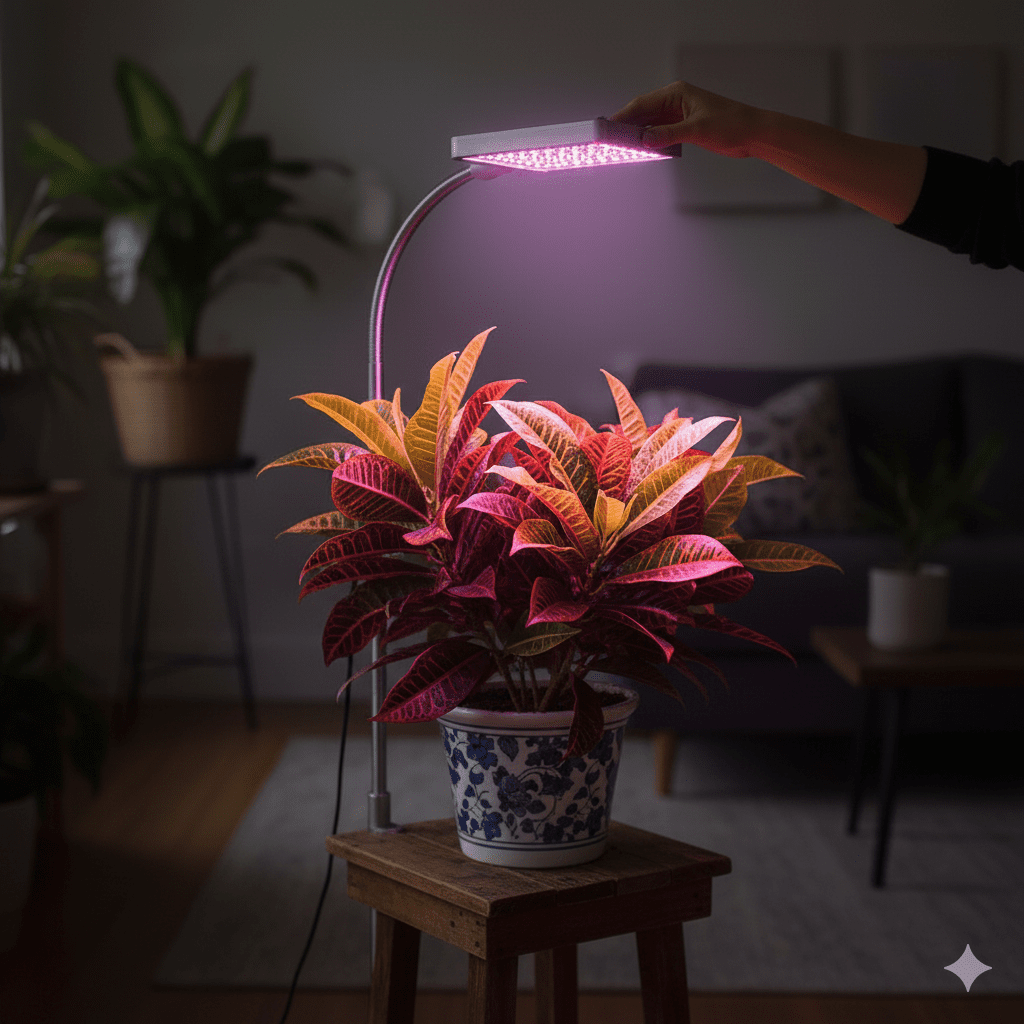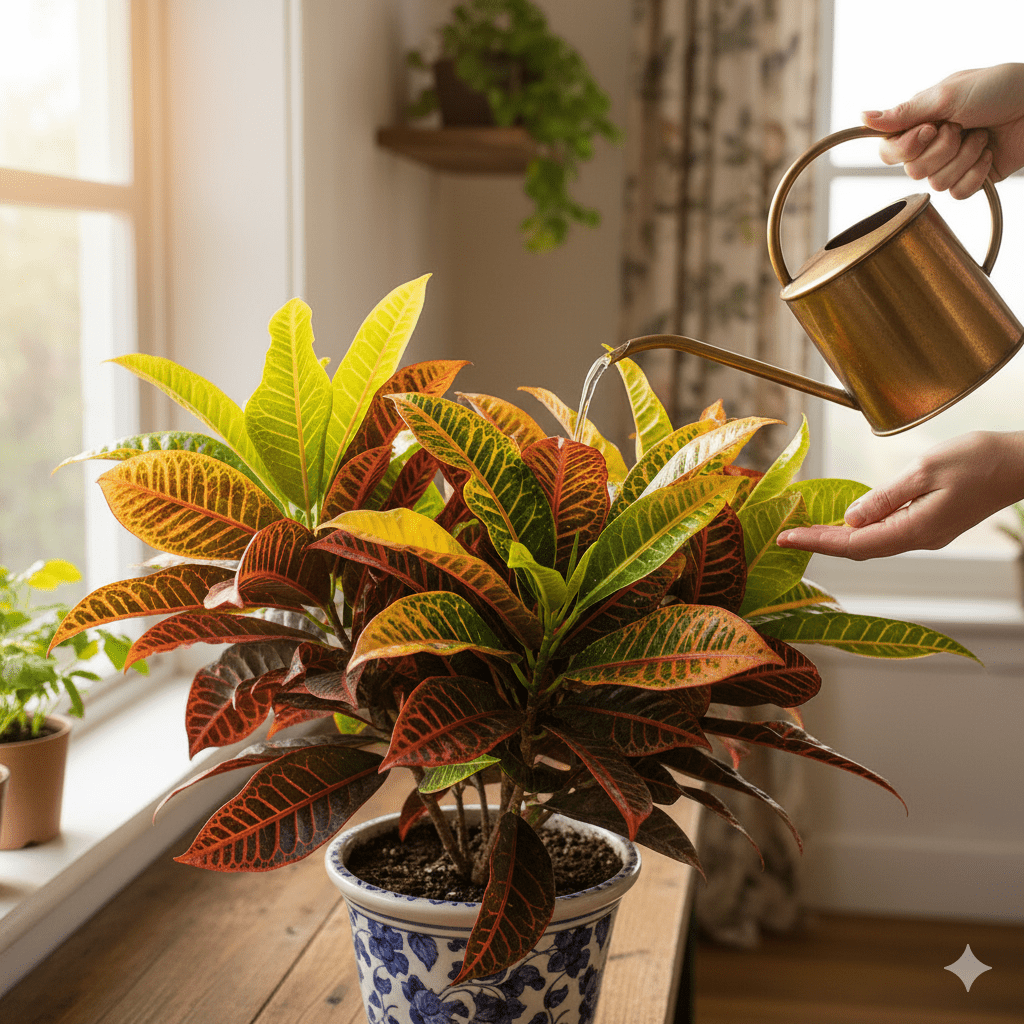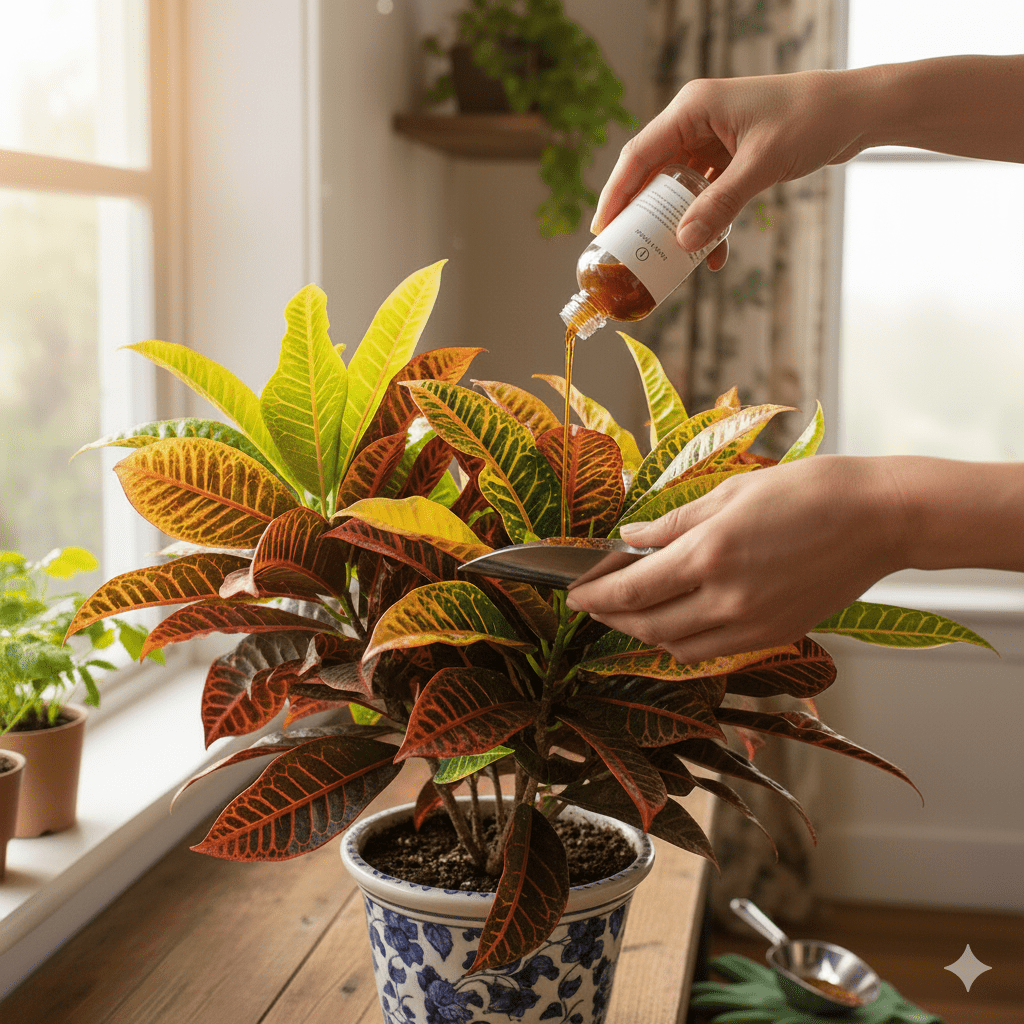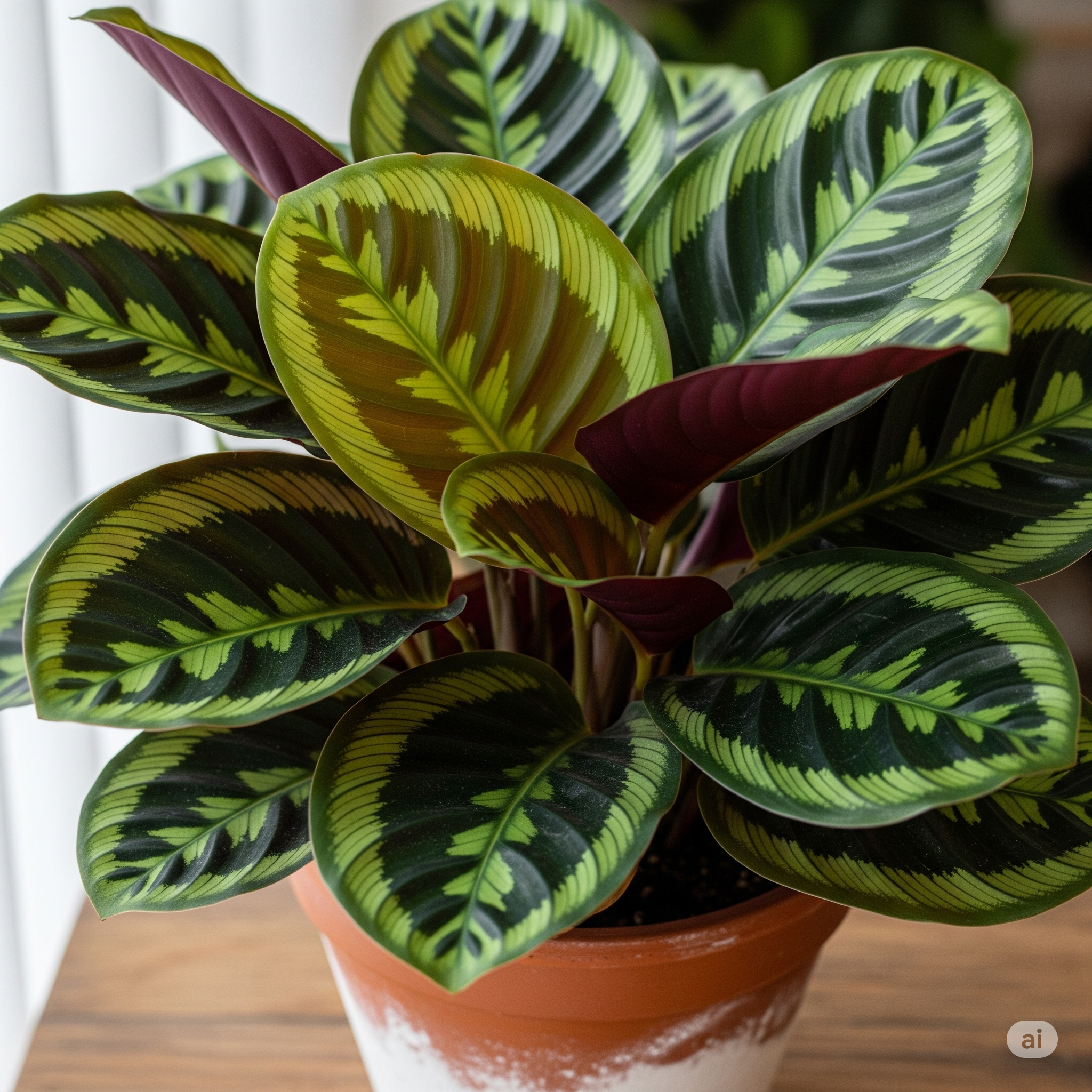Some links on this Website are affiliate links, meaning we may earn a commission if you make a purchase, at no additional cost to you. Please read our full Affiliate Disclosure for more details.
If you’ve ever come across a Proton Plant, often referred to as a Croton Plant (Codiaeum variegatum), you’ll instantly understand why it’s such a favorite among indoor gardeners. Its bold, tropical leaves burst with vivid colors, deep greens, yellows, oranges, reds, and even purples that bring life to any space. However, as stunning as it looks, caring for a Proton Plant takes some know-how.

This tropical beauty has a reputation for being a little dramatic when its growing conditions aren’t perfect. But don’t worry, once you understand its needs, caring for a Proton Plant becomes straightforward and rewarding.
In this detailed guide, we’ll cover everything you need to know about Proton Plant care, from the best lighting conditions and watering routine to fertilizing, pruning, and dealing with common problems.
Understanding the Proton Plant
The Proton Plant originates from the warm, humid climates of Southeast Asia and the Pacific Islands. In its natural environment, it thrives under dappled sunlight with moist, well-draining soil.
Because of its tropical nature, your Proton Plant prefers similar conditions indoors, that is, plenty of light, regular watering, and humidity. When you replicate its native habitat, your plant will reward you with rich, colorful foliage that instantly brightens your home or garden.
The Best Tips To Care For Proton Plant
1. Light Requirements for Proton Plant Care

Light is important in Proton Plant care. These plants love light, in fact, the more bright indirect light they receive, the more vibrant their colors become.
Place your Proton Plant in a spot where it can enjoy bright but filtered sunlight, such as near an east-facing or south-facing window. If you’re growing it outdoors, choose a location with partial shade since direct afternoon sun can scorch the leaves, while too little light causes the colors to fade and leaves to turn green or dull.
If you notice that your plant’s vibrant hues start disappearing or its growth seems slow, that’s a clear sign it’s not getting enough light. On the other hand, if the leaves become dry or curled at the edges, they might be receiving too much direct sunlight. Adjusting the position can make a huge difference in your Proton Plant’s overall health.
5 Best Gardening light meter For Plant Care
2. Watering the Proton Plant Properly

Watering is where most people make mistakes when caring for a Proton Plant. These plants like consistent moisture, but they don’t tolerate soggy soil.
A good rule of thumb is to water when the top inch of soil feels dry to the touch. Always water thoroughly until it drains out the bottom of the pot. This ensures that the roots receive enough hydration. Avoid letting the plant sit in standing water, as this can quickly lead to root rot.
During the warmer months, you may need to water more often, while in winter, you can reduce the frequency since growth slows down. If you notice the leaves wilting or turning brown at the edges, your Proton Plant may need more water or higher humidity.
Because these plants thrive in humid environments, try misting the leaves regularly or using a humidity tray. Grouping your Proton Plant with other houseplants can also help maintain moisture levels in the air.
Can I Save A Plant From Root Rot?
How To Aerate The Soil In A Potted Plant
3. Choosing the Right Soil for Proton Plants
The right soil mix plays a big role in the health of your Proton Plant. Since it prefers slightly moist but well-draining conditions, the soil must be able to retain some moisture without becoming compacted.
An ideal mix would be equal parts peat moss, perlite, and garden soil. Peat moss helps retain moisture, while perlite improves drainage and prevents waterlogging. You can also use a high-quality potting mix labeled for tropical or indoor plants.
Make sure the pot you use has drainage holes to allow excess water to escape. The Proton Plant’s roots are sensitive and can easily rot if left in waterlogged soil. For best results, refresh the soil every 2–3 years when repotting.
How To Identify Root Rot In Succulents
Does Potting Soil Go Bad? Can You Fix It?
4. Ideal Temperature and Humidity Conditions
Since the Proton Plant comes from tropical regions, it loves warmth and humidity. It performs best in temperatures between 60°F and 85°F (15°C to 29°C). Avoid exposing it to temperatures below 55°F (13°C), as cold air can shock the plant and cause leaf drop.
Humidity is equally important. Low humidity levels can cause leaf edges to brown or curl. To create a humid environment indoors, try misting your plant every few days or using a humidifier. You can also place the pot on a tray filled with water and pebbles; as the water evaporates, it will increase humidity around the plant.
Avoid placing the Proton Plant near air conditioners, heaters, or drafty windows, as sudden temperature changes can stress the plant.
10 Succulent Plants That Grow Tall
5. Fertilizing Your Proton Plant

To maintain its bright and colorful foliage, the Proton Plant benefits from regular feeding during the growing season.
Use a balanced, water-soluble fertilizer (such as 10-10-10) every 4–6 weeks during spring and summer. Always dilute the fertilizer to half the recommended strength to prevent root burn. During fall and winter, cut back on fertilizing since the plant’s growth slows down.
Over-fertilizing can harm your Proton Plant, so remember, a little goes a long way. If you notice white crusts forming on the soil’s surface, flush the soil with water to remove excess fertilizer salts.
6. Pruning and General Maintenance

Regular pruning helps keep your Proton Plant looking full and bushy. If your plant grows too tall or starts looking leggy, trim the top growth to encourage side branching. You can use the cuttings for propagation (more on that later).
Remove any yellowing or damaged leaves to maintain the plant’s appearance and prevent disease. Cleaning the leaves with a soft, damp cloth also helps the plant breathe better and enhances its natural shine.
Proton Plants respond well to pruning, and with consistent trimming, you’ll have a lush, compact plant that looks as good as the day you bought it.
15 Best Indoor Plants for Cold Temperatures
7. When and How to Repot Your Proton Plant
Like most houseplants, Proton Plants eventually outgrow their pots. Repotting gives them fresh nutrients and room to spread their roots.
You should repot every 2–3 years, preferably in spring or early summer. To do this:
- Gently remove the plant from its current pot.
- Loosen the roots and trim any that appear mushy or damaged.
- Place it into a slightly larger pot with fresh potting soil.
- Water thoroughly and keep it in a shaded area for a few days to help it recover.
After repotting, your Proton Plant will usually experience a small adjustment period, but it will soon bounce back with renewed vigor.
Common Proton Plant Problems and Solutions
Even with proper care, Proton Plants can sometimes show signs of stress. Here’s how to identify and fix common issues:
- Dropping leaves: Often due to cold drafts or sudden temperature changes. Move the plant to a warmer, stable environment.
- Brown leaf tips: Caused by low humidity or underwatering. Increase humidity by misting the leaves regularly.
- Faded leaf colors: A sign of inadequate light. Move your Proton Plant to a brighter spot with indirect sunlight.
- Sticky residue on leaves: This could indicate pest infestations like mealybugs or aphids. Wipe the leaves with soapy water or neem oil to get rid of pests naturally.
Propagating the Proton Plant
Propagation is a simple way to grow new Proton Plants from the one you already have. The easiest method is through stem cuttings.
Here’s how to do it:
- Cut a healthy stem about 4–6 inches long with a few leaves attached.
- Dip the cut end into rooting hormone powder.
- Plant the cutting in moist potting soil or water.
- Cover it loosely with a plastic bag to maintain humidity.
- Place it in a warm, bright spot with indirect light until new roots develop.
Once the cutting starts producing new growth, you can transfer it to a permanent pot. With time and care, you’ll have a brand-new Proton Plant to add to your collection.
Frequently Asked Questions (FAQ)
1. Is the Proton Plant easy to care for?
Yes. Once you understand its light and humidity needs, the Proton Plant is relatively easy to maintain and grows well indoors.
2. Why are my Proton Plant leaves falling off?
Leaf drop is usually caused by cold drafts, overwatering, or sudden environmental changes. Make sure your plant is in a warm, stable location.
3. Can I grow a Proton Plant outdoors?
Yes, you can, but only in warm, tropical, or subtropical regions. Keep it in partial shade to protect the leaves from scorching sunlight.
4. How often should I water my Proton Plant?
Water when the top inch of soil feels dry. Overwatering can cause root rot, while underwatering may lead to dry, crispy leaves.
5. How do I make my Proton Plant more colorful?
Provide bright, indirect sunlight and use balanced fertilizer during the growing season. Light and nutrients are key to vibrant foliage.

